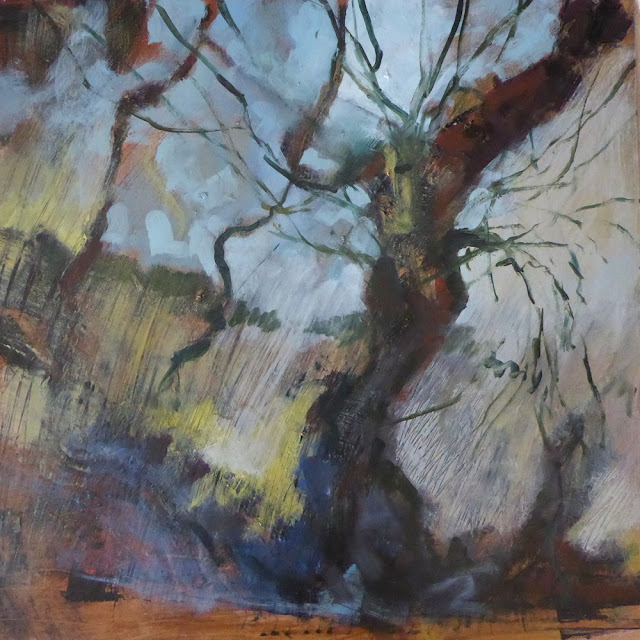Some initial notes and paintings on the Hawthorne Tree
 |
| Hawthorne Turton Moor oil on board 50x50cm |
Once in a while whilst painting or drawing outdoors I feel a need to go tree hugging. Late last summer I was particularly attracted to a line of very old Hawthornes that clung to a wall, part of an old mine tramway or farmers track that ran across Turton Moor. Their bent and twisted deep blue and mauve forms showed real age yet their trunks where small and their branches twisted fractured and bent.
This is my third tree series, the first was a group of ancient mountain ash in Rivington which I started to draw almost twenty years ago.The second a group of Olive trees set on a steep slope near Gauguin Andalucia.
A quick internet search shows that the Hawthorne Tree plays a venerable part in British Folklore and history.
https://whisperingearth.co.uk/2010/05/31/may-tree-myth-and-medicine/
Hawthorn has been common in Britain for millennia, pollen counts showing its presence here before 6,000 BC, and of all our native trees, it is perhaps the most enshrined in myth and legend. From Celtic ceremony, to Arthurian myth, to Christian legend, the Hawthorn has its place in all the stories that shape our land and our hearts.
In pagan spirituality, the Hawthorn was a symbol of fertility, youth and sexuality and was considered sacred to the Goddess. It is believed that in Celtic times, most marriages took place at this time of year, usually at Beltaine, the cross quarter festival marking the mid-point between the spring equinox and the summer solstice. Hawthorn would have been in full bloom, bringing abundant blessings to the newly weds. Today, its historical symbolism and its affinity with the heart have resulted in it being considered the tree of love. Despite marrying in August, we used branches of Hawthorn, among other trees, in our wedding ceremony last year.
Reacting against its saucy pagan associations, the Catholic Church made the pure white blossoms a symbol of the Virgin Mary and of chastity. It was also said to be the wood from which the crown of thorns worn by Jesus was made. The Glastonbury Thorn, which flowers once in May and again at Christmas was said to have grown from the staff of Joseph of Arimathea, which took root when he brought Christianity to the British Isles.
There are thought to be up to 1,000 species of Hawthorn worldwide, the two most common in the UK are Crataegus monogyna and Crataegus laevigata. Usually white, the blossoms may also be a light or deep pink.
http://www.ecoenchantments.co.uk/myogham_hawthornpage.html


Comments
Post a Comment